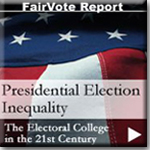Problems with the Whole Number Proportional and Congressional District Systems
By Monideepa Talukdar, Robert Richie, and Ryan O'Donnell
Published August 9th 2007
This paper analyzes two of the three major options available to state leaders interested in taking action to reform how their state allocates its Electoral College votes: the whole number proportional and congressional district systems. It evaluates them on the basis of whether they promote majority rule, make elections more nationally competitive, reduce incentives for partisan machinations, and make all votes count equally. We use vote returns from a number of previous elections to analyze what the outcomes would have been if Electoral College votes had been allocated according to the whole number proportional and the congressional district systems.
Our analysis reveals that both of these methods fail to meet our criteria. Neither reform option promotes majority rule, greater competitiveness, or voter equality. Pursued at a state level, both reforms dramatically increase incentives for partisan machinations. If done nationally, the congressional district system has a sharp partisan tilt toward the Republican Party. The whole number proportional system sharply increases the odds of contingent elections (the selection of president by Congress).



